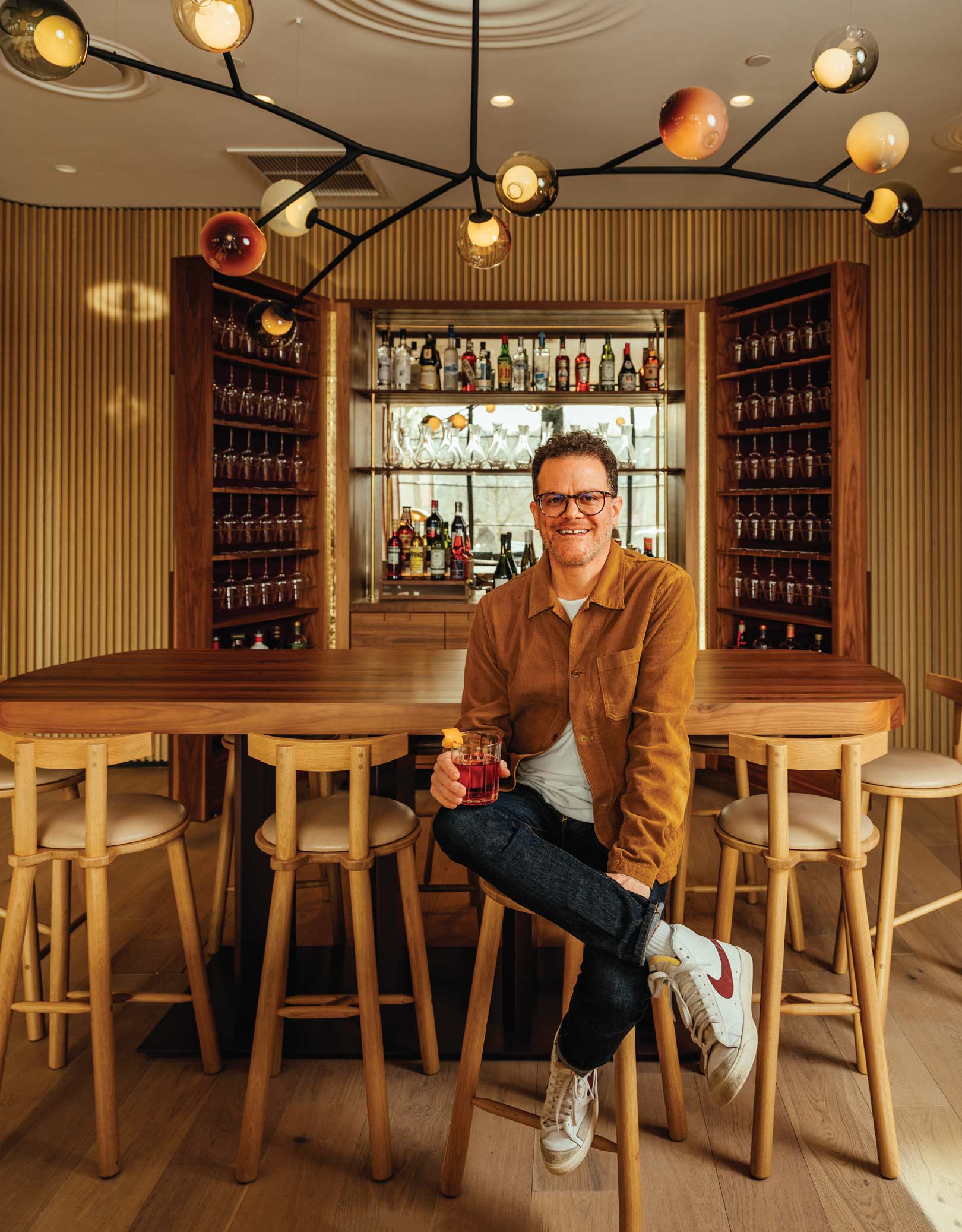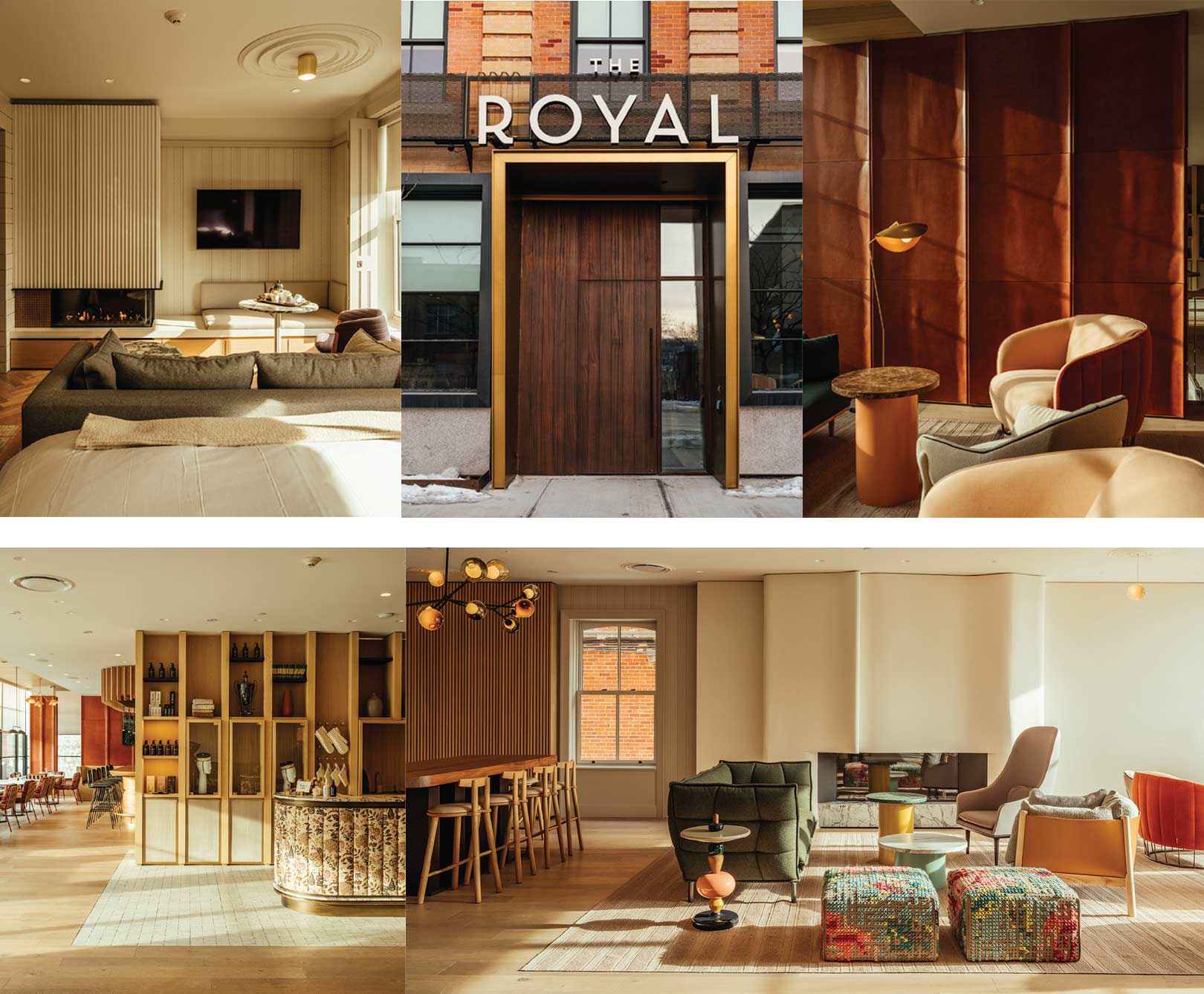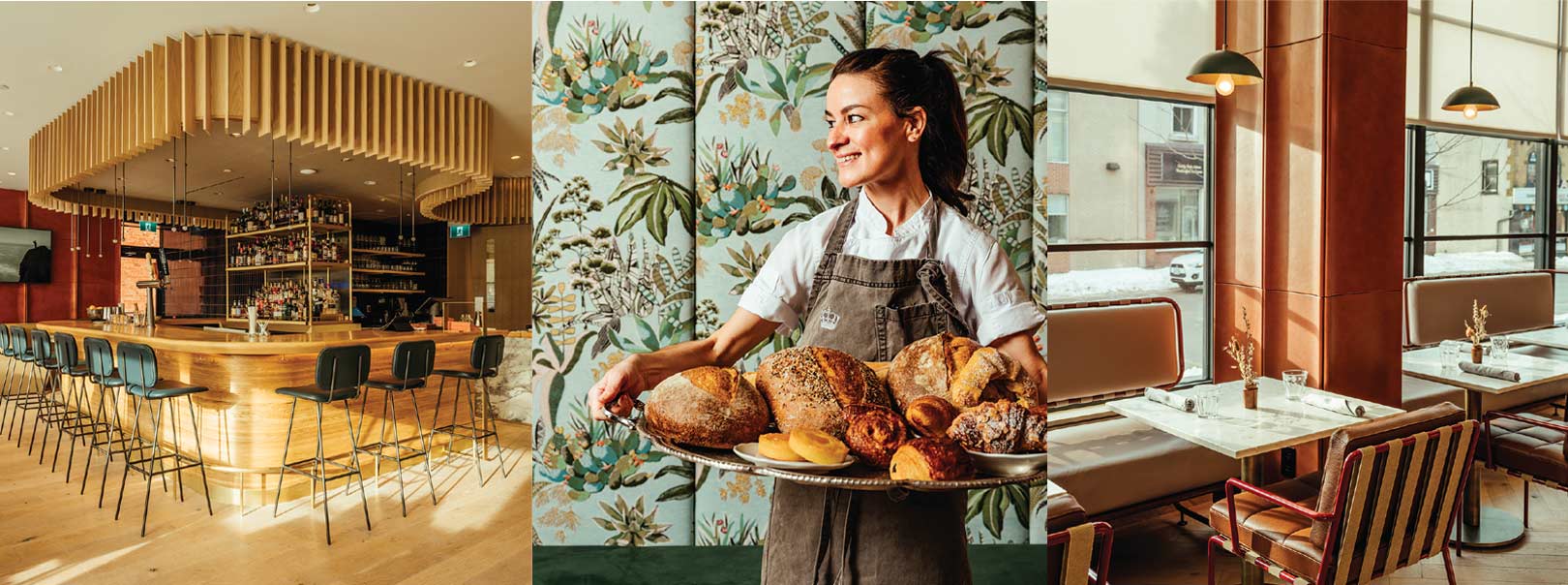


The impossible possible beautiful formula that resurrected The Royal Hotel
It’s late morning, post-breakfast and pre-lunch, but the streetside bakery café and bar at The Royal Hotel in Picton are full and there’s a line. Some of these faces are familiar because they’re County, some because they belong to folks who’ve achieved fame in their various pursuits, and the rest are a diverse bunch of upscale out-of-towners. Somehow, we’re all absolutely comfortable here – the environment is totally on point. The ambient hum of the room swings between joyful chatter and blissed-out sighs responding to forkfuls of Fogo Island cod dressed in brown butter Béarnaise. After a dramatic construction phase and a slew of the most unimaginable setbacks, The Royal Hotel is game on, and in this complex puzzle of grandiose design, it’s the guests who comprise the final, exquisite piece. We represent the culmination of a hard-won dream of former Ontario finance minister, Greg Sorbara.
THE BACKSTORY
The Royal Hotel began its life in the late 1800s as a luxurious railway hotel that would become the heart of Picton culture and society. “For decades, it was the place to be,” says Sol Korngold, general manager of The Royal, son-in-law of Greg Sorbara, and the production mastermind behind the hotel’s five-year development. “It was the grand hotel in town, frequented by business people and locals in all their finery, a place where servers wore white gloves to pour afternoon tea.”
The Royal was incarnated again and again, through lean and fat eras, over two global pandemics, two World Wars, a technological revolution, the enactment and repeal of prohibition, and, because nothing’s new, the ongoing reimagining of Prince Edward County society. Still today the old locals wax nostalgic over the hotel’s revival back in the 60s and 70s, when it served as a dance and band venue, fondly remembered for “rough drinks” and good times. “Decades later it became a rooming house and then stood vacant,” Sol says. “The holes in the roof and missing windows allowed the elements and animals to claim it as their own.” Despite hopes for a resurrection, the building ultimately stood vacant for more than a decade, eventually falling into total disrepair.
“It needed someone to rebuild it,” Greg says, “and I quickly realized that the ‘someone’ was me and my family.”
THE HOTEL
“At first I imagined a relatively modest interior renovation,” Greg recounts, “but after inspection I realized it would be a much larger undertaking. We retained top notch architects – Giannone Petricone Associates – and proceeded with countless family meetings to settle on what we wanted to achieve.”
Greg’s mission was to give back to the community the elegance that the original hotel had some 140 years ago. That was the “restoration” part. The construction part was to fashion a modern hotel within the skin and the spirit of the original Royal. “Early on we settled on having my son-in-law Sol Korngold take the lead on getting the Royal rebuilt and into full operation,” Greg says. “The result is a great tribute to the genius he brought to the project.”
Looking at the genius of Sol from a comfortable perch in one of the hotel’s numerous stunning spaces is unfairly easy. Of course, The Royal is beautiful – you only need to run your fingers over the delicately woven wallpaper, drool over the beautiful tilework in the bathrooms, or gaze upon the magnificent central light feature in the dining room to know it – but recognizing that every tiny detail, both seen and unseen, withstood the pressure of Sol’s thumbprint reveals the real depth and breadth of his vision. “I lay in bed at night and all I thought about was the hotel for literally five years,” he admits.
“I understand my own limitations so I brought in consultants to help me,” says Sol, who comes across as essentially unburdened by ego. Despite the onslaught of delays, he persevered single-mindedly with what was always a challenging project, overcoming the sheer complexity of construction and holding the build to high standards at every turn. From start to finish, he saw how the parts would come together, carefully selecting and relying on experts who would make each element shine. “The Royal isn’t just a hotel,” he explains, “it’s actually two restaurants, a bakery, a café, several bars, a dining room, a retail pop-up, a spa and a hotel. It’s several vertical businesses under the same roof that all need to work well together.”
The formula is simple, maybe: make versatile spaces that are equally comfortable from morning to night and from cool in July to warm in February. “The café at the Counter Bar is a place to linger. During the day it’s bright and relaxed. At night, the lights dim and the music goes up, sultry and cool. Having this flexibility in design was key for operating a hotel in a seasonal market,” Sol says.
In the dining room, floor-to-ceiling glass doors are retractable to seamlessly connect the terrace dining in spring, summer and fall. A few steps down, warm summer nights are celebrated at a large fireside family table in the garden that sits beneath a pergola, surrounded by comfy seats and coffee tables under the canopy of red oak trees near the trailer bar. The hotel pool completes the rear garden, where guests can swim or lounge waterside, curled up under an umbrella with a book and cocktail. The Royal’s spaces unfold with the seasons, mirroring the philosophy of the restaurant and the farm.
“The café at the Counter Bar is a place to linger. During the day it’s bright and relaxed. At night, the lights dim and the music goes up, sultry and cool.”
THE FARM
Twenty minutes up the road from the hotel, on 700 acres in Northport, Edwin County Farms was originally a property on which the Sorbara family congregated and grew their own food. Greg’s wife Kate had always grown much of the food her family ate, and their son Nick got behind the idea of expanding the garden into a commercial one that ultimately became the primary source of seasonal, organic vegetables for The Royal. With acres of produce, an organic maple syrup operation, bed upon bed of flowers and about fifty head of Black Angus cattle, the farm became the cornerstone for the restaurant’s vision.
“My grandfather was a farmer,” says Nick, who runs Edwin County Farms along with his brother Lucas. “My mom was a hobby farmer, and until I started playing baseball as a young teen, I wanted to be a farmer too. I went into film instead, became a producer and started my own production company and from there a post-production company, called Redlab, where I am still a partner.” About five years ago the family took a culinary trip to New York where they visited Dan Barber’s restaurant, Blue Hill at Stone Barns, and toured their beautiful farm. Throughout the tour, the Sorbaras were impressed and inspired and dreamily suggesting “we could do this on our farm,” and “we could do that on our farm.”
Nick continues, “I rolled my eyes and thought, who is going to do ‘this and that’ on our farm? But by the end of our tour, something happened. I felt the producer in me waking up and suddenly I was saying, ‘I’ll do this at our farm.’ So I came home and studied everything I could about farming, from books and journals to YouTube videos and podcasts. I attended intensive market garden workshops at Erich Schultz’s Steadfast Farm in Arizona and Jean-Martin Fortier’s Ferme des Quatre-Temps in Quebec – and the rest I figured out with my hands in the dirt.
“We started with maple syrup,” Nick explains, “and it’s become our most established product from the farm. Then we developed our market garden to service The Royal, but with construction delays we began selling produce to friends’ restaurants in Toronto – Brothers, Terroni, Cumbraes. Edwin County Farms was in twenty restaurants in the city.”
When COVID hit, they decided to refocus their efforts in the County and stopped delivering to Toronto. They built a farm stand and sold products at their farm gate, joined the Picton farmers’ market and sold to local restaurants like Flame + Smith, The Drake, Stellas, and Bocado. “It felt amazing,” Nick says. “I loved it. From delivering the crops to local chefs to feeding our community great organic produce that we had grown – I loved it all.”
The fact that Chef Albert Ponzo was brought in five years before the kitchen opened demonstrates the Sorbaras’ level of commitment and their confidence in the pairing.
As Nick talks, Edwin County Farms suddenly emerges as a distinct entity of the Sorbaras’ business, one that’s nurturing its own big picture. “Another aspect of the farm that we’re beginning to explore is the forest,” Nick says. “We have been foraging some tree crops that will hopefully find their way onto the Royal menu, like our shagbark hickory syrup featured in the hotel’s Old Smoked Fashioned. Albert (Ponzo) and I have been experimenting with acorn flour made from Edwin County Farms acorns. We find they have a delicious, nutty flavour when baked in cookies and an earthy, almost mushroom flavour when cooked in a savoury dish like polenta.”
Nick’s vision for the farm is both insightful and innovative, creating a sustainable way towards conservation, while experimenting with interesting ingredient opportunities.
THE FOOD
The Sorbara family is dialed into food and the culinary scene in a big way, so there was no doubt that the kitchen at The Royal would be something to be reckoned with, and that the chef would be a wildly talented visionary. The fact that Chef Albert Ponzo was brought in five years before the kitchen opened demonstrates both the Sorbaras’ towering level of commitment and their confidence in the pairing.
With a decade at the helm of Toronto’s beloved Le Sélect Bistro, Albert was the perfect choice to head up the restaurant at The Royal. Over and above his widely acknowledged talent in the kitchen, he’d long championed the local and sustainable movements, and his heart was already leaning into the County.
“I was already coming here once a year with my family,” Albert says, referring to his sommelier wife Marlise and their three young children. “We’d already set our sights on moving here permanently and were imagining a farm-to-table restaurant. I’d become more and more immersed in French table cooking over the years at Le Sélect and wanted to go beyond that to put myself into the farm experience. So I left Le Sélect in February 2017 and moved to the County on Canada Day.”
“Albert and I met and I think it was love at first sight for both of us,” Sol confesses. “I invited him to come to my house and we cooked and ate and he made a gorgeous dinner. We talked a lot about our ideas for the menu and the kind of thing we were trying to build.” The rest was, as they say, history. From the start, Albert became a fixture at the farm helping to determine what should be grown for the hotel. “And it doesn’t stop with the farm,” Sol says as he points to hyper-local examples on the menu – the haskap berries on the Crema al Limone were Nick-picked from bushes across the County; the local burrata was made just across the road by restaurateur Jesse Fader. “There’s also the Cressy Mustard in our shop that comes from up the road in Waupoos, all the local wines and spirits, Birra Del Campo that Midtown Brewery developed for us, and even the SHED alpaca products in our shop – to name a few.”
“Getting your hands dirty and growing things yourself makes you realize how little you actually know about the journey of food,” Albert says. “But when you’re successful, you get a real appreciation and love for the produce, and you don’t want to mess with it too much. You seek out the best ingredients and do the minimal work you have to do, but you don’t over-prepare them and don’t crowd them. That’s my goal with the restaurant at The Royal. Help those ingredients to be expressed in their best form, let them shine on their own and grow our repertoire.”
Beverage Manager Michael Bracegirdle approaches The Royal’s cocktail program from the same viewpoint. “I want to take that same inspiration so that there’s a flow to the restaurant.” Michael’s house Caesar infuses beet juice with the Clamato. “As our beets evolve over the seasons, the colour of the Caesar actually changes,” he explains. “In the fall, the cocktail was this beautiful pinky-purple and in winter, as the year deepened, it was a darker, firmer purple – an amazing visual of seasonality.”
In a world saturated with rookie sourdough, Sarah Villamere’s loaves are actually divine. “I bake for everyone else like I baked for myself – in a way, I feel as though I’m taking care of people.”
Another talked-about Royal offering is baked goods. Former pastry chef at the acclaimed Fogo Island Inn, Sarah Villamere, is baking her way into patrons’ hearts. “I guess I approach baking the same way I do cooking,” she says. “Balance is really important to me, whether it be through flavours, textures, and of course, great ingredients. I bake for everyone else like I baked for myself – in a way, I feel as though I’m taking care of people.” In a world saturated with rookie sourdough, Sarah’s loaves are actually divine.
A MELDING OF WORLDS
The Royal Hotel is alive and kicking again thanks to a team with incredible vision and industry. Perhaps the most remarkable piece of the hotel’s resurrection is the weaving of rural sentiment into an establishment that’s a truly metropolitan hotel. So far, the indicators point to a successful melding of worlds: the largely local hotel staff are intensely efficient and capable, but also friendly. The food program is world class, while relying heavily on seasonal ingredients from local producers. Indeed, no part of the hotel is suffering from a dependency on the rural influence – instead, the experience is elevated by it. And Sol Korngold has crafted an environment that emanates low-key elegance without the trappings of pretension.
Financial investment aside, it was a bold stroke for the Sorbaras to undertake the rejuvenation of this hotel. And they didn’t do it in a haphazard “Let’s hang the old sign” way but met the challenge to build something important that’s truly County with its rich and varied history, a real experience of the seasons, a relationship to the land, a hard, meaningful, creative work ethic, and a community engaged to support the whole thing. This is the recipe that makes an establishment iconic, and it’s the reason The Royal Hotel’s beautiful bricks will emanate a powerful sense of place in Prince Edward County for centuries to come.
Story by:
Lonelle Selbo
Photography by:
Johnny C.Y. Lam


